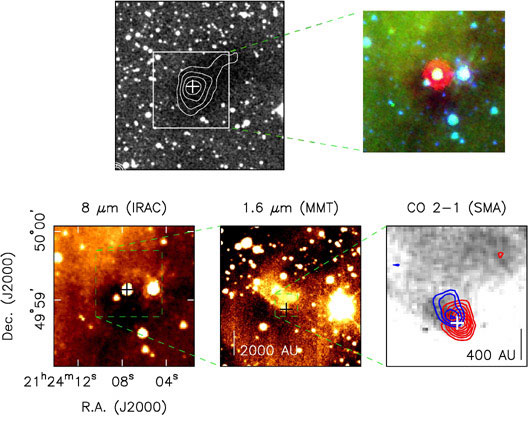Unborn Star Revealed

A space cloud that is featureless on the outside contains a star about to be born, astronomers found upon closer inspection.
The object was initially classified as starless, so researchers were surprised when a faint infrared light was found at its core.
The star may be the runt of the litter, however
The star is cool and faint, shining at about 1/20th the power of the Sun. It may grow into a full-blow star when fully developed, or it may stall out and become a brown dwarf, a sort of failed star that straddles the line between planet and star.
When stars are born, material flows outward. With this star, there's 10 times less stuff coming out than from any similar object. That suggests the low mass, said astronomers at the Harvard-Smithsonian Center for Astrophysics (CfA).
The object has about 25 times the mass of Jupiter, the range that would make a brown dwarf. But scientists don't know whether it will pick up more mass before the process is done.
But astronomers have not seen all aspects of starbirth because the activity is typically buried inside a natal cloud of gas and dust.
Get the Space.com Newsletter
Breaking space news, the latest updates on rocket launches, skywatching events and more!
"The most elusive part of star formation is the moment of birth," said CfA astronomer Phil Myers. "In order to answer how it happens, you need examples of very young systems. This system is only about 10,000 to 100,000 years
old-a baby as far as stars or brown dwarfs go."
The puzzling object, inside a cloud names L1014, was discovered using NASA's Spitzer Space Telescope. The look inside was made with the Submillimeter Array (SMA) in Hawaii. The observations were announced last week.
"The SMA spotted what no single-dish telescope could see," said CfA astronomer Tyler Bourke.
The object is 600 light-years away in the constellation Cygnus the Swan.
Near-infrared observations by the MMT Observatory in Arizona revealed a scattered light nebula surrounding the faint central object in L1014. "Light from the object is bouncing off surrounding dust and toward us," said CfA astronomer Tracy Huard, who took the MMT images. "Reflection nebulosity like that is a fingerprint of an embedded object."
By studying faint, young objects like this, astronomers hope to learn more about the early stages of star formation.
This article is part of SPACE.com's weekly Mystery Monday series.
- How a Star is Born: Clouds Lift on Missing Link
- Hubble Images Show Birth and Death in Stellar Nursery
- Origins Revealed: Sun and Earth Born amid Chaos
Join our Space Forums to keep talking space on the latest missions, night sky and more! And if you have a news tip, correction or comment, let us know at: community@space.com.

Space.com is the premier source of space exploration, innovation and astronomy news, chronicling (and celebrating) humanity's ongoing expansion across the final frontier. Originally founded in 1999, Space.com is, and always has been, the passion of writers and editors who are space fans and also trained journalists. Our current news team consists of Editor-in-Chief Tariq Malik; Editor Hanneke Weitering, Senior Space Writer Mike Wall; Senior Writer Meghan Bartels; Senior Writer Chelsea Gohd, Senior Writer Tereza Pultarova and Staff Writer Alexander Cox, focusing on e-commerce. Senior Producer Steve Spaleta oversees our space videos, with Diana Whitcroft as our Social Media Editor.









